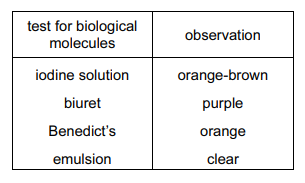Question
Tests were performed on samples from a mixture of biological molecules.
When iodine in potassium iodide solution was added to a sample, the mixture turned black.
When the biuret test was carried out on another sample, the mixture turned purple.
Which biological molecules were in the mixture?
A amylase and starch
B cellulose and starch
C phospholipid and cellulose
D starch and phospholipid
▶️Answer/Explanation
The iodine test is used to detect the presence of starch, and the black color indicates that starch is present in the sample. Amylase is an enzyme that breaks down starch into smaller sugars, so the presence of both amylase and starch in the mixture would explain why the iodine test is positive.
The biuret test is used to detect the presence of proteins. The purple color indicates that proteins are present in the sample. However, none of the answer choices include proteins, so the biuret test result is not relevant to identifying the biological molecules in the mixture.
Question
Which substances contain carbon, hydrogen, oxygen and nitrogen?
1 collagen
2 amylopectin
3 deoxyribonucleic acid
A 2 only
B 1 and 3 only
C 2 and 3 only
D 1, 2 and 3
▶️Answer/Explanation
Answer B
The substances that contain carbon, hydrogen, oxygen, and nitrogen are:
1. Collagen
3. Deoxyribonucleic acid
Therefore, the answer is B, 1 and 3 only. Amylopectin is a polysaccharide made up of glucose monomers and does not contain nitrogen.
Collagen is a fibrous protein that is a major component of connective tissues such as tendons, ligaments, and cartilage. It is composed of amino acids that contain carbon, hydrogen, oxygen, and nitrogen. The nitrogen is present in the amino groups (-NH2) of the amino acids that make up the protein.
Deoxyribonucleic acid (DNA) is a molecule that contains the genetic information that is passed from one generation to the next. It is composed of nucleotides, which are made up of a sugar molecule, a phosphate group, and a nitrogen-containing base. The four nitrogen-containing bases found in DNA are adenine (A), cytosine (C), guanine (G), and thymine (T). These nitrogen-containing bases are responsible for the presence of nitrogen in DNA.
Amylopectin, on the other hand, is a polysaccharide that is composed of glucose monomers. It is a carbohydrate and does not contain nitrogen.
Question
Which molecules have properties that are dependent on hydrogen bonds?
- cellulose
- glycogen
- haemoglobin
- water
A 1, 2 and 3 only B 1, 2 and 4 only C 1, 3 and 4 only D 2, 3 and 4 only
▶️Answer/Explanation
Ans: C
The molecules that have properties that are dependent on hydrogen bonds are:
1. Cellulose
4. Water
Therefore, the answer is C, 1, 3, and 4 only.
Cellulose is a polysaccharide that is made up of glucose monomers. It is an important structural component of plant cell walls. The hydrogen bonds between adjacent cellulose molecules give the plant cell wall its strength and rigidity.
Water is a polar molecule that is capable of forming hydrogen bonds with other water molecules. These hydrogen bonds give water its high boiling point, high specific heat capacity, and many other unique properties.
Question
Each list, 1, 2 and 3, shows some substances found in animal tissues.
- glucose, cholesterol, triglycerides, water.
- glycogen, antibodies, adenine, phospholipids.
- haemoglobin, carbon dioxide, mRNA, monosaccharides.
Which shows one or more substances that contain nitrogen atoms?
▶️Answer/Explanation
Ans: D
The list that shows one or more substances that contain nitrogen atoms is:
2. Glycogen, antibodies, adenine, phospholipids.
3. Haemoglobin, carbon dioxide, mRNA, monosaccharides.
Therefore, the answer is D, 2 and 3 only.
Haemoglobin is a protein found in red blood cells that is responsible for carrying oxygen from the lungs to the rest of the body. It contains nitrogen in the amino acids that make up the protein.
Carbon dioxide is a molecule that is produced by cells during cellular respiration. It contains one carbon atom and two oxygen atoms, but no nitrogen.
mRNA is a molecule that is involved in the process of protein synthesis. It contains nitrogen in the nitrogenous bases that make up the molecule.
Monosaccharides are simple sugars that are used as a source of energy by cells. They contain carbon, hydrogen, and oxygen, but no nitrogen.
Question
A student carried out four tests for biological molecules on a solution. The results are shown in the table.

Which three molecules may be present in this solution?
- glucose, starch, globin
- globin, glucose, collagen
- starch, sucrose, collagen
- sucrose, globin, collagen
Answer/Explanation
Ans:
B
1) Iodine test is a test for detecting the presence of starch. The sample turns blue-black in color when a few drops of potassium iodide solution are placed on the sample. As no color change is observed in the solution, this means it lacks starch.
2) The biuret test is a chemical test that can be used to check for the presence of peptide bonds in a given analyte. Biuret solution is a blue liquid that changes to purple color when it reacts with proteins .
3) Benedict’s test is a chemical test that can be used to check for the presence of reducing sugars in a given analyte. Color change to orange indicates presence of reducing sugar such as glucose.
4) Emulsion test is done to show the presence of lipids in a substance. Because lipids are insoluble in water, they will become immiscible, meaning they will not mix with the water. As a result, any lipids present in your sample will float to the top and form a milky white emulsion. As we observed a clear emulsion, this means the solution lacks lipids.
Thus, correct option is B.
